Indian Ocean trade
Indian Ocean trade has been a key factor in East–West exchanges throughout history. Long-distance trade in dhows and proas made it a dynamic zone of interaction between peoples, cultures, and civilizations stretching from Southeast Asia to East and Southeast Africa and East Mediterranean in the West in prehistoric and early historic periods. Cities and states on the Indian Ocean rim focused on both the sea and the land.
Early period
There was an extensive maritime trade network operating between the
Several coastal settlements like Sotkagen-dor (astride Dasht River, north of Jiwani),
Indo-Mediterranean trade network
Recent
Austronesian maritime trade network
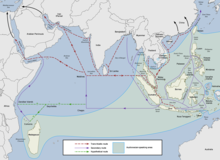
The maritime trade network in the Indian Ocean was run by the
Hellenistic and Roman period
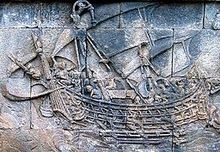
Trade between India and the Greek Ptolemaic Kingdom was started by Eudoxus of Cyzicus in 130 BCE. From Egypt, goods could be sent on to ports throughout the Mediterranean. The Kingdom's opening of Red Sea ports and improved knowledge of the seasonal monsoons resulted in a substantial increase in trade.
The consolidation of the administration of the Mediterranean basin under the
At any rate, when
Ptolemies, only a very few ventured to undertake the voyage and to carry on traffic in Indian merchandise.— Strabo
Strabo's mention of the vast increase in trade following the Roman annexation of Egypt indicates that the monsoon was known and utilized for trade in his time.[15] So much gold was used for this trade, and apparently recycled by the Kushan Empire (Kushans) for their own coinage, that Pliny the Elder (NH VI.101) complained about the drain of specie to India:[16]
Roman ports
The three main Roman ports involved with eastern trade were Arsinoe, Berenice and Myos Hormos. Arsinoe was one of the early trading centers but was soon overshadowed by the more easily accessible Myos Hormos and Berenice.
Arsinoe
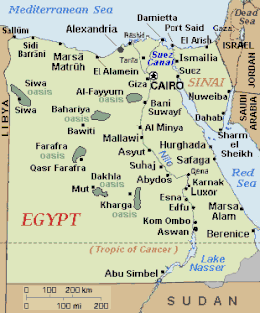
The Ptolemaic dynasty exploited the strategic position of Alexandria to secure trade with the subcontinent.[17] The course of trade with the east then seems to have been first through the harbor of Arsinoe, the present day Suez.[17] The goods from the East African trade were landed at one of the three main Roman ports, Arsinoe, Berenice or Myos Hormos.[18] The Romans repaired and cleared out the silted up canal from the Nile to harbor center of Arsinoe on the Red Sea.[19] This was one of the many efforts the Roman administration had to undertake to divert as much of the trade to the maritime routes as possible.[19]
Arsinoe was eventually overshadowed by the rising prominence of Myos Hormos.
Myos Hormos and Berenice
Myos Hormos and Berenice appear to have been important ancient trading ports, possibly used by the
The site of Berenice, since its discovery by Belzoni (1818), has been equated with the ruins near
South Asian ports
The regional ports of
Barigaza
Trade with Barigaza, under the control of the
There are imported into this market-town (
Barigaza), wine, Italian preferred, also Laodicean and Arabian; copper, tin, and lead; coral and topaz; thin clothing and inferior sorts of all kinds; bright-colored girdles a cubit wide; storax, sweet clover, flint glass, realgar, antimony, gold and silver coin, on which there is a profit when exchanged for the money of the country; and ointment, but not very costly and not much. And for the King there are brought into those places very costly vessels of silver, singing boys, beautiful maidens for the harem, fine wines, thin clothing of the finest weaves, and the choicest ointments. There are exported from these places spikenard, costus, bdellium, ivory, agate and carnelian, lycium, cotton cloth of all kinds, silk cloth, mallow cloth, yarn, long pepper and such other things as are brought here from the various market-towns. Those bound for this market-town from Egypt make the voyage favorably about the month of July, that is Epiphi.— Periplus of the Erythraean Sea (paragraph 49).
Muziris

According to the Periplus, numerous Greek seamen managed an intense trade with Muziris:[22]
Then come Naura and Tyndis, the first markets of
Kingdom of Cerobothra; it is a village in plain sight by the sea. Muziris, of the same Kingdom, abounds in ships sent there with cargoes from Arabia, and by the Greeks; it is located on a river, distant from Tyndis by river and sea five hundred stadia, and up the river from the shore twenty stadia"— The Periplus of the Erythraean Sea (53–54)
Arikamedu
The
Decline and legacy
Following the
The decline in trade saw the
Greater India Hindu-Buddhist period
The Satavahanas developed shipping ventures in Southeast Asia. The 8th century depiction of a wooden double outrigger and sailed Borobudur ship in ancient Java suggests that there were ancient trading links across the Indian Ocean between Indonesia and Madagascar and East Africa sometimes referred to as the 'Cinnamon Route.' The single or double outrigger is a typical feature of vessels of the seafaring Austronesians and the most likely vessel used for their voyages and exploration across Southeast Asia, Oceania, and Indian Ocean.[31] During this period, between 7th to 13th century in Indonesian archipelago flourished the Srivijaya thalassocracy empire that rule the maritime trade network in maritime Southeast Asia and connecting India and China.
Chinese travel
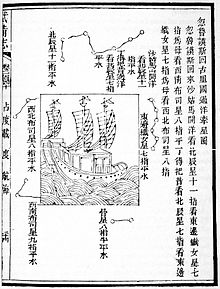
Chinese fleets under Zheng He crisscrossed the Indian Ocean during the early part of the 15th century. The missions were diplomatic rather than commercial, but many exchanges of gift and produces were made.
Japanese trade
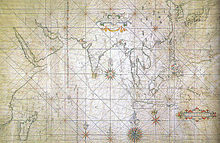
During the 16th and 17th century,
Muslim period
- See also: Indian Ocean slave trade
During the Muslim period, in which the Muslims had dominated the trade across the Indian Ocean, the
Muslim missionaries and merchants began to spread Islam along the western shores of the Indian Ocean from the 8th century, if not earlier. A Swahili stone mosque dating to the 8th–15th centuries has been found in Shanga, Kenya. Trade across the Indian Ocean gradually introduced the Arabic script, and rice as a staple in Eastern Africa.[33] Muslim merchants traded an estimated 1000 African slaves annually between 800 and 1700, a number that grew to c. 4000 during the 18th century, and 3700 during the period 1800–1870. Slave trade also occurred in the eastern Indian Ocean before the Dutch settled there around 1600 but the volume of this trade is unknown.[34]
In Madagascar, merchants and slave traders from the Middle East (Shirazi Persians, Omani Arabs, Arabized Jews, accompanied by Bantus from southeast Africa) and from Asia (
European colonial exploration period
Portuguese period
The Portuguese under Vasco da Gama discovered a naval route to the Indian Ocean through the southern tip of Africa in 1497–98. Initially, the Portuguese were mainly active in Calicut, but the northern region of Gujarat was even more important for trade, and an essential intermediary in east–west trade.[32]
European slave trade in the Indian Ocean began when Portugal established Estado da Índia in the early 16th century. From then until the 1830s, c. 200 slaves were exported from Mozambique annually and similar figures has been estimated for slaves brought from Asia to the Philippines during the Iberian Union (1580–1640).[34]
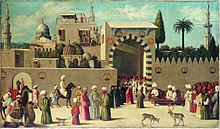
Venetian interests were directly threatened as the traditional trade patterns were eliminated and the Portuguese became able to undersell the Venetians in the spice trade in Europe. Venice broke diplomatic relations with Portugal and started to look at ways to counter its intervention in the Indian Ocean, sending an ambassador to the Egyptian court.[38] Venice negotiated for Egyptian tariffs to be lowered to facilitate competition with the Portuguese, and suggested that "rapid and secret remedies" be taken against the Portuguese.[38] The Mamluks sent a fleet in 1507 under Amir Husain Al-Kurdi, which would fight in the Battle of Chaul.[38]
The Ottomans tried to challenge Portugal's hegemony in the Persian Gulf region by sending an armada against the Portuguese under Ali Bey in 1581. They were supported in this endeavor by the chiefs of several local principalities and port towns such as
Dutch and English period
During the 16th century the
The establishment of the
The East India Company (EIC) was established during the same period and in 1622 one of its ships carried slaves from the Coromandel Coast to Dutch East Indies. The EIC mostly traded in African slaves but also some Asian slaves purchased from Indian, Indonesian and Chinese slave traders. The French established colonies on the islands of Réunion and Mauritius in 1721; by 1735 some 7,200 slaves populated the Mascarene Islands, a number which had reached 133,000 in 1807. The British captured the islands in 1810, however, and because the British had prohibited the slave trade in 1807 a system of clandestine slave trade developed to bring slaves to French planters on the islands; in all 336,000–388,000 slaves were deported to the Mascarane Islands from 1670 until 1848.[34]
In all, Europeans traders deported 567,900–733,200 slaves within the Indian Ocean between 1500 and 1850 and almost that same amount were deported from the Indian Ocean to the Americas during the same period. Slave trade in the Indian Ocean was, nevertheless, very limited compared to c. 12,000,000 slaves deported across the Atlantic.[34]
See also
- Ancient maritime history
- Chantal Radimilahy
- Greater India
- History of Indian influence on Southeast Asia
- Illegal drug trade in the Indian Ocean region
- Indian diaspora
- Indianised kingdom
- Indianization of Southeast Asia
- Indian Maritime History
- Indian Ocean slave trade
- Indosphere
- Maritime Silk Road
- Tamil loanwords in Biblical Hebrew
- Winds in the Age of Sail
References
- ^ PMID 33419922.
- ^ Wu, Katherine J. "Painted Bronze Age Monkeys Hint at the Interconnectedness of the Ancient World". Smithsonian Magazine. Retrieved 6 March 2021.
- ^ Neyland, R. S. (1992). "The seagoing vessels on Dilmun seals". In Keith, D.H.; Carrell T.L. (eds.). Underwater archaeology proceedings of the Society for Historical Archaeology Conference at Kingston, Jamaica 1992. Tucson, AZ: Society for Historical Archaeology. pp. 68–74.
- PMID 33419922.
- ^ Possehl, Gregory L. (4 July 2012). "Were There Commercial Communications between Prehistoric Harappans and African Populations?". Scientific Research. 2: 169–180.
- ^ Gupta, Sunil (1999–2000). "From Eastern Indian Ocean to the Yellow sea interaction sphere: Indo-Pacific beads in Yayoi Japan" (PDF). Purātattva. 30: 93–97.
- S2CID 191984538.
- ^ ISBN 9783319338224.
- ^ Doran, Edwin Jr. (1974). "Outrigger Ages". The Journal of the Polynesian Society. 83 (2): 130–140. Archived from the original on 18 January 2020. Retrieved 14 July 2019.
- ISBN 0415100542.
- ISBN 9780890961070.
- ^ Blench, Roger (2004). "Fruits and arboriculture in the Indo-Pacific region". Bulletin of the Indo-Pacific Prehistory Association. 24 (The Taipei Papers (Volume 2)): 31–50.
- ^ Lach 1994: 13
- ^ "The Geography of Strabo published in Vol. I of the Loeb Classical Library edition, (II.5.12.) 1917".
- ^ Young 2001: 20
- ^ "minimaque computatione miliens centena milia sestertium annis omnibus India et Seres et paeninsula illa imperio nostro adimunt: tanti nobis deliciae et feminae constant. quota enim portio ex illis ad deos, quaeso, iam vel ad inferos pertinet?" Pliny, Historia Naturae 12.41.84.
- ^ a b c Lindsay 2006: 101
- ^ O'Leary 2001: 72
- ^ a b c Fayle 2006: 52
- ^ a b Freeman 2003: 72
- ^ a b c d Shaw 2003: 426
- ^ a b c d Halsall, Paul. "Ancient History Sourcebook: The Periplus of the Erythraean Sea: Travel and Trade in the Indian Ocean by a Merchant of the First Century". Fordham University.
- ^ a b "Search for India's ancient city". BBC. 11 June 2006. Retrieved 4 January 2010.
- ^ George Menachery, Kodungallur City of St. Thomas, Azhikode,1987alias Kodungallur Cradle of Christianity in India, 2000
- ^ Mudur, G.S. (3 August 2009). "Signs of ancient port in Kerala - Pattanam mentioned in Indian & Greek texts". Archived from the original on 4 February 2016.
- ^ a b Huntingford 1980: 119.
- ^ Farrokh 2007: 252
- ^ a b Meri 2006: 224
- ^ Holl 2003: 9
- ^ Kulke 2004: 106
- ^ Borobudur Ship Expedition
- ^ a b c d Foundations of the Portuguese empire, hi lo millo1415–1580 Bailey Wallys Diffie p.234ff [1]
- ^ LaViolette 2008, Conversion to Islam and Islamic Practice, pp. 39–40
- ^ a b c d e Allen 2017, Slave Trading in the Indian Ocean: An Overview, pp. 295–299
- ^ Larson, 2000
- ISBN 0-325-00217-7.
- ^ Lawler. "Ancient crop remains record epic migration to Madagascar". Science: 30 May 2016
- ^ a b c Foundations of the Portuguese empire, 1415–1580 Bailey Wallys Diffie p.230ff [2]
Sources
- Allen, R. B. (2017). "Ending the history of silence: reconstructing European slave trading in the Indian Ocean" (PDF). Tempo. 23 (2): 294–313. . Retrieved 30 June 2019.
- LaViolette, A. (2008). "Swahili cosmopolitanism in Africa and the Indian Ocean world, AD 600–1500". Archaeologies. 4 (1): 24–49. S2CID 128591857. Retrieved 23 February 2019.
